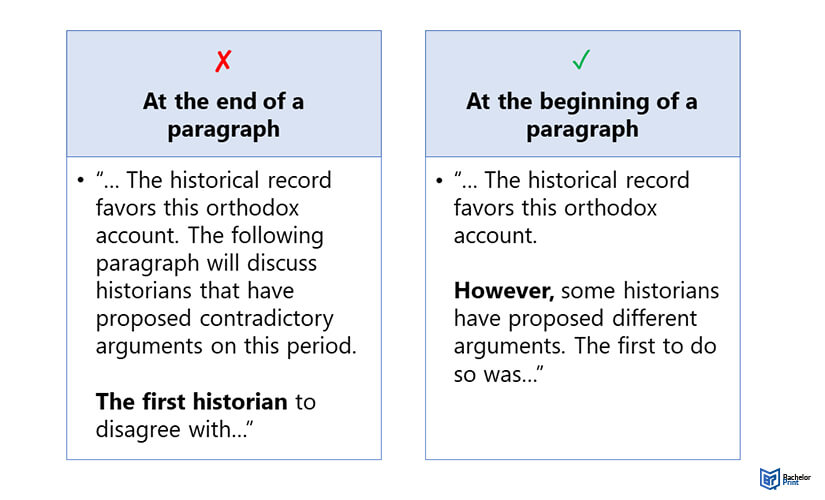
Transition sentences play an important role in academic writing, as they contribute to the logical flow and connectivity of an argument. They serve as bridges between ideas, providing a seamless reading experience. Understanding and efficiently implementing transition sentences can greatly improve coherence and clarity of an academic essay. This article delves into the various types of transition sentences and provides examples to aid in their effective application in writing.
Definition: Transition sentences
Transition sentences are crucial to the flow of a paper and for clear comprehension. They help guide a reader through a piece of research; its findings and arguments. They also help to understand how central ideas in your paper are connected.
As such, transition sentences are used to structure paragraphs and link up sections. This commonly involves referring to language or phrases used in a previous paragraph at the beginning of a new one.
What makes good transition sentences?
Good transition sentences make explicit connections between ideas in a way that’s unique to your paper.
While we tend to use specific words and phrases in transition sentences, you should avoid the use of “this”. It’s not always clear what “this” means – so the more specific the transition, the better.
Oftentimes, it just takes a few tweaks to create a convincing connection between sentences. Use of signposting language, like “however”, “furthermore”, “by comparison”, etc., helps carry thoughts through from sentence to sentence. The best transition sentences, however, are more specific.
Here, the paragraphs are organically transitioned in the discussion of “the company” and “profits”.
Transition sentences between paragraphs
Transition sentences between paragraphs aim to introduce what a new paragraph is about and how it links to the previous paragraph. You can utilize a range of linking words to make this transition clear.
Transition sentences generally appear at the beginning of a paragraph. As each paragraph contains its own focal topic, you should avoid explaining what’s to come at the end of a paragraph. This is a waste of time and risks becoming over-explanatory.

Transition sentences to indicate a new section
Unlike transitions between paragraphs, new sections often require a more detailed breakdown of previous arguments and how you’ll build on them or provide a new direction.
It’s good practice to dedicate a whole paragraph to this sort of transition if needed. This works to summarize your previous section while indicating how you’ll build on or provide new evidence.
However, the general academic consensus of being as clear and concise as possible still applies. If you can transition to a new section in just one sentence, that will suffice.
Transition sentences within a paragraph
Transition sentences within paragraphs are important for the flow of a paper as a way to lead a reader through your argument.
Here are some ways to implement transition sentences and phrases within paragraphs.
The known-new contract
Known-new is a writing concept for sentence structure. It recommends that new sentences should begin with a reference to a previous sentence (the known) before connecting that to new information.
Arguments should be presented within the known-new contract order for clarity and cohesion. What’s more, by repeating known information, you also make an argument clearer by recognizing its key points.
By restructuring the passage so that the second sentence transitions more smoothly from the first, you can produce a more effective piece of writing.
The transition comes sooner in the sentence, creating a more obvious link between the two sentences. While this known-new contract is recommended, you don’t have to apply it to every sentence. Try it out when you’re struggling to get two sentences to flow.
Transition words and phrases
Transition words and phrases are simple language tools used to connect sentences. There are four groups:
- Additive: These transitions introduce new information or evidence.
- Adversative: These transitions indicate a contradiction or moving on.
- Causal: These transitions deal with cause and effect.
- Sequential: These transitions underscore a sequence.
Grouping similar information
While transition words are recommended for flow, too many can lead to wordy passages. To avoid over-using transition words, similar information can simply be grouped for clarity. This helps produce a clearer and cleaner bit of text.
FAQs
Transition sentences are like bridges between sentences, allowing you to connect different ideas or indicate a development in an argument.
They aid comprehension to develop stronger written arguments.
They let readers know of connections between evidence and function as introductions to topics. They also signpost when a topic changes or a new argument is being formed.
Without transition sentences, sentences would appear random, unorganized, and difficult to read.
All academic writing should aim for clarity, and transition sentences help this.
numerous advantages for Canadian students:
- ✓ 3D live preview of your configuration
- ✓ Free express delivery for every order
- ✓ High-quality bindings with individual embossing
